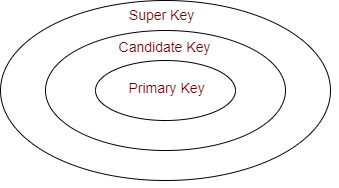
 Data Structure
Data Structure Networking
Networking RDBMS
RDBMS Operating System
Operating System Java
Java MS Excel
MS Excel iOS
iOS HTML
HTML CSS
CSS Android
Android Python
Python C Programming
C Programming C++
C++ C#
C# MongoDB
MongoDB MySQL
MySQL Javascript
Javascript PHP
PHP
- Selected Reading
- UPSC IAS Exams Notes
- Developer's Best Practices
- Questions and Answers
- Effective Resume Writing
- HR Interview Questions
- Computer Glossary
- Who is Who
Normal Forms Based on Primary Keys
Normalization is a process of organizing data in a database to reduce redundancy and improve data consistency. Primary keys are really important in organizing information in a database. They help to make sure that every row in a table has a unique identification so that nothing gets mixed up or lost.
In this article, we will discuss different normal forms based on primary keys and their importance in ensuring data consistency.
Introduction
Let's discuss how we make sure that data in databases is organized properly. We use something called "functional dependencies" to help us do this. Each table in the database has a special identifier called a "primary key." We also have some rules that help us organize the data properly, called "normal forms."
Types of Keys used in Normalization
There are several types of keys used in normalization in database management systems (DBMS). These are explained as follows.

Super Key
A super key is a set of one or more attributes that uniquely identifies each record in a table. A super key may contain more attributes than necessary to uniquely identify each record.
Candidate Key
A candidate key is a minimal super key that can uniquely identify each record in a table. In other words, it is a super key that does not contain any unnecessary attributes.
Primary Key
A primary key is a candidate key that has been selected to uniquely identify each record in a table. It is used to enforce entity integrity, and is typically denoted by an underline or a key symbol.
Alternate Key
An alternate key is a candidate key that is not selected to be the primary key. It is used to enforce uniqueness, and may be used as a reference key in another table.
Foreign Key
A foreign key is a key that is used to link two tables together. It is a column (or set of columns) in one table that refers to the primary key of another table.
By using these different types of keys, DBMS designers can ensure that data is organized properly, free of redundancy, and can be retrieved efficiently. Normalization helps to reduce data anomalies and inconsistencies, and ensures that databases are scalable and easy to maintain.
Normal Forms Based on Primary Keys
Normalization is the process of organizing data in a database to minimize redundancy and dependency. In database design, there are different normal forms based on the primary keys of a table. These include ?

First Normal Form (1NF)
1NF requires that each column in a table contains atomic values and that each row is uniquely identified. This means that a table cannot have repeating groups or arrays as columns, and each row must have a unique primary key. For example, a table that lists customer orders with a column for order items violates 1NF because the order items are not atomic values.
Second Normal Form (2NF)
2NF builds on 1NF by requiring that each non-primary key column in a table is fully functionally dependent on the primary key. This means that a table should not have partial dependencies, where a non-primary key column depends on only part of the primary key. For example, a table that lists customer orders with a primary key of order ID and non-primary key columns for customer ID and customer name violates 2NF because customer name depends on only customer ID and not on the full primary key.
Third Normal Form (3NF)
3NF builds on 2NF by requiring that each non-primary key column in a table is not transitively dependent on the primary key. This means that a table should not have transitive dependencies, where a non-primary key column depends on another non-primary key column. For example, a table that lists customer orders with a primary key of order ID and non-primary key columns for customer ID, customer name, and customer city violates 3NF because customer city depends on only customer ID and not on the full primary key.
Boyce-Codd Normal Form (BCNF)
BCNF is a stricter form of 3NF that applies to tables with more than one candidate key. BCNF requires that each non-trivial dependency in a table is a dependency on a candidate key. This means that a table should not have non-trivial dependencies, where a non-primary key column depends on another non-primary key column. BCNF ensures that each table in a database is a separate entity and eliminates redundancies.
Fourth Normal Form (4NF)
4NF builds on BCNF by requiring that a table should not have multi-valued dependencies. A multi-valued dependency occurs when a non-primary key column depends on a combination of other non-primary key columns. For example, a table that lists customer orders with a primary key of order ID and non-primary key columns for customer ID and order items violates 4NF because order items depend on both order ID and customer ID.
Conclusion
Normalization is an essential process in database design that ensures data consistency and reduces redundancy. Primary keys play a critical role in normalization by uniquely identifying each row in a table. The different normal forms based on primary keys provide a systematic way of ensuring data consistency and eliminating data anomalies.

